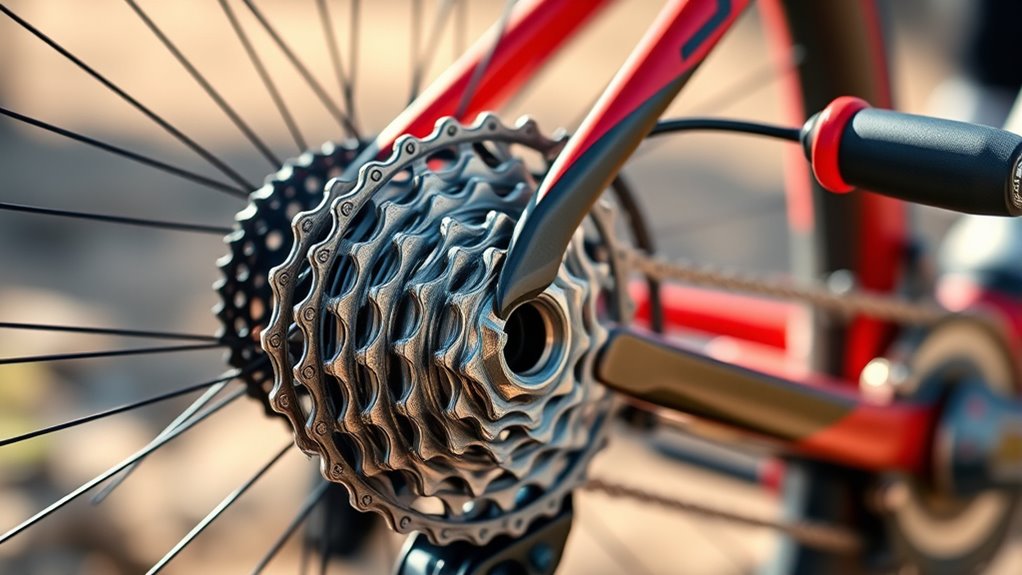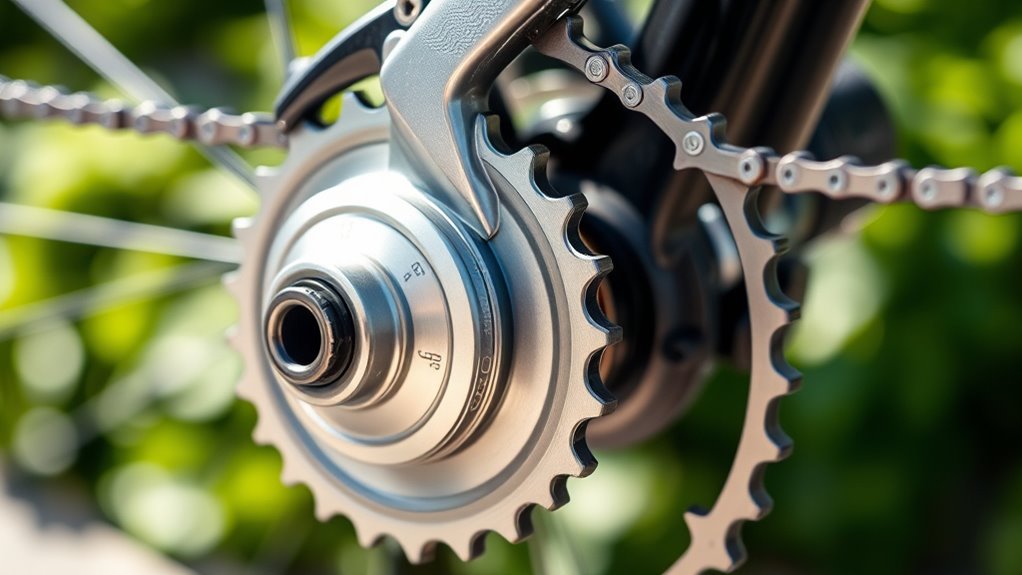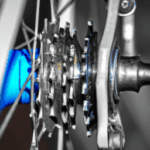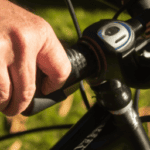Bike gearing lets you adjust how hard or easy it is to pedal, making riding more efficient on different terrains. When you change gears, the derailleur moves the chain across different sprockets, affecting the gear ratio. A lower gear makes pedaling easier for uphill climbs, while a higher gear boosts speed on flats. Understanding how your gears work helps you ride smoothly and comfortably. Keep exploring to discover how to make the most of your bike’s gearing system.
Key Takeaways
- Bike gearing uses different sprockets and chainrings to change the gear ratio, affecting pedaling effort and speed.
- The derailleur moves the chain across sprockets to select the desired gear ratio for terrain or riding conditions.
- Gear ratios determine how many wheel rotations occur per pedal stroke, balancing effort and speed.
- Proper gear shifting involves precise derailleur movement, maintaining chain tension and alignment.
- Adjusting gears helps optimize pedaling efficiency, making riding easier uphill or faster on flat and downhill sections.

Have you ever wondered how cyclists effortlessly switch gears to conquer different terrains? It might seem like magic, but it’s actually all about gear ratios and derailleur mechanics working together seamlessly. When you change gears, you’re adjusting the mechanical setup that controls how your pedaling force is translated into wheel movement. The core concept behind this is gear ratios, which determine how many times your wheel turns for each pedal stroke. A lower gear ratio makes pedaling easier, especially uphill, by increasing the number of wheel rotations per pedal revolution. Conversely, a higher gear ratio delivers more speed on flat terrain or downhill because the wheel turns fewer times per pedal stroke.
Your bike’s derailleur is the key component that manages these gear changes. It’s a small but precise mechanism mounted on the derailleur hanger that moves the chain across different sprockets or cogs on the cassette. When you shift gears using the shifter, your hand activates the derailleur, which then shifts the chain onto a different sprocket. This change alters the gear ratio instantly, allowing you to adapt to varying inclines or speeds. The derailleur’s mechanics involve a spring-loaded arm that guides the chain from one sprocket to another, maintaining tension and alignment. This process requires careful calibration to guarantee that shifts are quick, accurate, and don’t cause chain drops or slipping.
The derailleur shifts the chain smoothly across sprockets, maintaining tension for precise, reliable gear changes.
Additionally, the gear ratios are carefully calculated to ensure smooth transitions and efficient power transfer during riding. Understanding how gear ratios work helps you make better decisions about shifting. For example, if you’re climbing a hill, shifting to a smaller sprocket in the rear cassette or a larger chainring in the front reduces the gear ratio, making pedaling less strenuous. On the other hand, when speeding on a flat stretch, you switch to a larger sprocket or smaller chainring for higher gear ratios that maximize your speed. The derailleur’s ability to precisely move the chain between sprockets is vital here. Its mechanics include a cage that guides the chain and a derailleur spring that pulls the chain into the selected sprocket. Proper maintenance guarantees this system functions smoothly, giving you confident, effortless shifting.
In essence, your bike’s gearing system combines smart gear ratios with finely tuned derailleur mechanics. This synergy allows you to tailor your pedaling effort to any terrain, helping you ride more efficiently and comfortably. Every shift is a carefully orchestrated movement that optimizes your power transfer and speed, making cycling a fluid and adaptable experience. Once you understand these basics, you’ll appreciate how your bike’s gearing system is designed to work tirelessly behind the scenes, making every ride smoother and more enjoyable.
Frequently Asked Questions
How Do I Choose the Right Gear for Different Terrains?
To choose the right gear for different terrains, you should use gear shifting techniques that match your riding conditions. On climbs, shift to lower gears to make pedaling easier, while on descents or flats, shift to higher gears for speed. Pay attention to your gear system components, ensuring smooth shifts. Anticipate terrain changes and shift early, avoiding cross-chaining, to maintain efficiency and reduce wear on your bike.
What Is the Optimal Gear Combination for Climbing Hills?
Oh, climbing hills? Just pretend you’re on a bicycle-powered rocket and shift to the smallest gear for maximum gear efficiency. Use smooth gear shifting techniques—no frantic cranking—to maintain momentum. Keep your cadence steady, avoid overexertion, and you’ll conquer inclines effortlessly. The key is to find that perfect combo of low gear and fluid shifts, making hill climbs feel like a breeze rather than a battle of wills.
How Does Gear Ratio Affect Bicycle Speed and Effort?
A higher gear ratio increases bicycle speed but requires more effort, making it ideal for flat terrain or descending. Conversely, a lower gear ratio reduces effort, helping you climb hills more easily, but limits your top speed. When you shift gears, you’re adjusting the gear ratio, directly impacting how much effort you need and how fast you can go. So, choose your gear ratio based on terrain and your desired balance of speed and effort.
How Often Should I Perform Maintenance on My Gear System?
You should perform maintenance on your gear system every 50 to 100 miles, depending on riding conditions. Keep to a regular lubrication schedule, applying lubricant to the derailleurs and cables to prevent rust and guarantee smooth shifting. Also, regularly check and adjust gear alignment to prevent slipping and wear. If you notice difficulty shifting or unusual noises, it’s time for an inspection and potentially more frequent maintenance.
Can I Upgrade My Bike’s Gearing System Easily?
Yes, upgrading your bike’s gearing system is usually straightforward if you check gear compatibility beforehand. You’ll need to make certain the new components match your bike’s specifications, especially the rear derailleur and shifters. Then, you can perform gear installation yourself or have a mechanic do it. Just remember, compatible gear parts make the upgrade smoother, and proper installation guarantees ideal shifting performance and longevity of your new system.
Conclusion
Just like a skilled composer adjusts the tempo to create harmony, understanding your bike’s gearing helps you ride smoothly through any terrain. With a little practice, you’ll master shifting gears effortlessly, revealing new levels of confidence and control. Remember, every ride is a journey—think of yourself as the conductor, guiding your bike through life’s unpredictable symphony. Embrace the rhythm, and let your gears carry you to your next adventure with ease.















